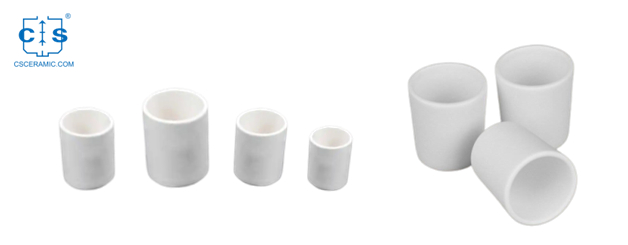Zirconia Ceramic Crucibles
———— Properties, Types, and Applications
Zirconia ceramic crucibles have become a popular choice for materials testing and analysis in various industries. These crucibles are made from high-quality zirconia ceramics, which offer excellent thermal and chemical resistance. In this article, we will explore the properties, types, and applications of zirconia ceramic crucibles in detail.
Table of Contents
-
Introduction to Zirconia Ceramic Crucibles
-
Properties of Zirconia Ceramic Crucibles
-
Types of Zirconia Ceramic Crucibles
Single-Use Crucibles
Reusable Crucibles
High-Temperature Crucibles
-
Applications of Zirconia Ceramic Crucibles
Metallurgy
Materials Science
Chemical Analysis
Glass ProductionPharmaceutical Manufacturing
-
Advantages of Zirconia Ceramic Crucibles
-
Disadvantages of Zirconia Ceramic Crucibles
-
How to Choose the Right Zirconia Ceramic Crucible
-
Maintenance and Care of Zirconia Ceramic Crucibles
-
Conclusion
-
FAQs
Introduction to Zirconia Ceramic Crucibles
Zirconia ceramic crucibles are used in many industries for materials testing, analysis, and production. These crucibles are made from high-quality zirconia ceramics, which offer superior thermal and chemical resistance compared to other materials such as porcelain, alumina, or graphite. Zirconia ceramics are known for their exceptional properties such as high melting point, low thermal conductivity, and excellent chemical stability.
Properties of Zirconia Ceramic Crucibles
Zirconia ceramic crucibles have several properties that make them suitable for a wide range of applications. Some of the key properties of zirconia ceramic crucibles include:
High Melting Point
Zirconia ceramics have a very high melting point, typically around 2700°C. This makes them ideal for use in high-temperature applications such as melting metals or glass.
Low Thermal Conductivity
Zirconia ceramics have a low thermal conductivity, meaning they do not transfer heat quickly. This property allows for even heating and cooling of the material being tested or produced, which is important for accurate results.
Chemical Stability
Zirconia ceramics are highly resistant to chemical corrosion and do not react with most acids or alkalis. This makes them ideal for use in chemical analysis or production.
Toughness
Zirconia ceramics have high fracture toughness, which makes them resistant to cracking or chipping. This is especially important for reusable crucibles, which can undergo several heating and cooling cycles.

Types of Zirconia Ceramic Crucibles
There are several types of zirconia ceramic crucibles available, each with its own unique features and benefits. Some of the most common types of zirconia ceramic crucibles include:
- Single-Use Crucibles
Single-use crucibles are designed for one-time use only and are typically used in applications where contamination is a concern. These crucibles are often made from high-purity zirconia ceramics to ensure that no impurities are introduced into the material being tested or produced.
- Reusable Crucibles
Reusable crucibles can be used multiple times and are often made from a blend of zirconia and alumina ceramics to improve their durability. These crucibles are ideal for applications where a high level of accuracy is required and contamination is not a concern.
- High-Temperature Crucibles
High-temperature crucibles are designed to withstand extreme temperatures, often up to 3000°C or more. These crucibles are often made from stabilized zirconia ceramics, which have higher thermal shock resistance than other types of zirconia ceramics.
Applications of Zirconia Ceramic Crucibles
Zirconia ceramic crucibles have a wide range of applications in various industries, including:
- Metallurgy
Zirconia ceramic crucibles are commonly used in metallurgy for materials testing and analysis. They are ideal for testing the melting point and composition of metals, as they can withstand high temperatures and do not react with most metals.
- Materials Science
In materials science, zirconia ceramic crucibles are used for research and development of new materials. They can be used to test the properties of different materials at high temperatures, which is essential for understanding their behavior in real-world applications.
- Chemical Analysis
Zirconia ceramic crucibles are used in chemical analysis for measuring the composition of various compounds. They are highly resistant to chemical corrosion, ensuring that the test results are accurate and not affected by contamination.
- Glass Production
In glass production, zirconia ceramic crucibles are used for melting and refining glass. They can withstand high temperatures and do not react with glass, ensuring that the final product is of high quality.
- Pharmaceutical Manufacturing
Zirconia ceramic crucibles are also used in pharmaceutical manufacturing for testing the purity and composition of drugs. They can withstand high temperatures and are highly resistant to chemical corrosion, ensuring that the test results are accurate and reliable.
Advantages of Zirconia Ceramic Crucibles
Some of the key advantages of zirconia ceramic crucibles include:
- High thermal and chemical resistance
- Excellent thermal shock resistance
- Low thermal conductivity for even heating and cooling
- High fracture toughness for durability
- Suitable for a wide range of applications
Disadvantages of Zirconia Ceramic Crucibles
Despite their many advantages, zirconia ceramic crucibles also have some disadvantages, including:
- High cost compared to other types of crucibles
- Not suitable for some applications where other materials such as graphite may be preferred
- Can crack or chip if dropped or mishandled
How to Choose the Right Zirconia Ceramic Crucible
Choosing the right zirconia ceramic crucible depends on several factors, including the specific application, temperature range, and material being tested or produced. Some of the key factors to consider when choosing a zirconia ceramic crucible include:
- Type of crucible (single-use, reusable, high-temperature)
- Size and shape of the crucible
- Temperature range
- Chemical compatibility with the material being tested or produced
Maintenance and Care of Zirconia Ceramic Crucibles
To ensure the longevity and accuracy of zirconia ceramic crucibles, it is important to follow proper maintenance and care procedures. Some tips for maintaining and caring for zirconia ceramic crucibles include:
- Store crucibles in a dry, cool place when not in use
- Handle crucibles carefully to avoid cracking or chipping
- Clean crucibles with a soft brush and mild detergent after each use
- Do not expose crucibles to sudden changes in temperature, as this can cause thermal shock
Conclusion
Zirconia ceramic crucibles are a valuable tool for materials testing, analysis, and production in various industries. With their excellent thermal and chemical resistance, zirconia ceramic crucibles offer several advantages over other types of crucibles. By understanding the properties, types, and applications of zirconia ceramic crucibles, you can choose the right crucible for your specific needs and ensure accurate and reliable test results.
FAQs
1. What is a zirconia ceramic crucible?
A zirconia ceramic crucible is a type of container made from zirconium dioxide. It is used for materials testing, analysis, and production in various industries due to its excellent thermal and chemical resistance.
2. What are the properties of zirconia ceramic crucibles?
Zirconia ceramic crucibles have several properties that make them ideal for various applications. These properties include high thermal and chemical resistance, excellent thermal shock resistance, low thermal conductivity for even heating and cooling, high fracture toughness for durability, and suitability for a wide range of applications.
3. What are the types of zirconia ceramic crucibles?
There are several types of zirconia ceramic crucibles, including single-use, reusable, and high-temperature crucibles. Single-use crucibles are typically used for one-time testing or production, while reusable crucibles can be used multiple times. High-temperature crucibles can withstand higher temperatures than standard crucibles, making them suitable for high-temperature applications.
4. What are the applications of zirconia ceramic crucibles?
Zirconia ceramic crucibles have a wide range of applications in various industries, including metallurgy, materials science, chemical analysis, glass production, and pharmaceutical manufacturing. They are commonly used for materials testing and analysis, as well as for melting and refining various materials.
5. How do I choose the right zirconia ceramic crucible for my application?
Choosing the right zirconia ceramic crucible depends on several factors, including the specific application, temperature range, and material being tested or produced. Factors to consider when choosing a zirconia ceramic crucible include the type of crucible, size and shape of the crucible, temperature range, and chemical compatibility with the material being tested or produced.
Thank you for reading. We invite you to visit CSCERAMIC for more information if you would like to learn more about industrial ceramic material and the advanced range of ceramic products we offer.




 info@csceramic.com
info@csceramic.com







 +86 18273288522
+86 18273288522